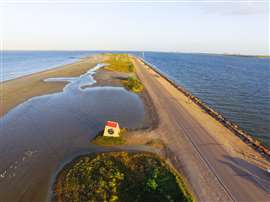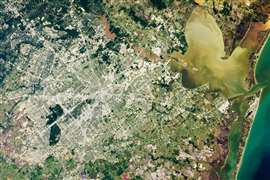Will America’s biggest-ever civil engineering project ever get started?
19 February 2024
Costs are ballooning for the Coastal Texas Project – commonly called the “Ike Dike” – and at US$57 billion (€52 billion), some are concerned the coastal barrier may never get built
 Aerial view of Texas City Dike, a levee that projects southeast into the mouth of Galveston Bay. It was designed to reduce the impact of sediment accumulation along the lower bay. (Image: Adobe Stock)
Aerial view of Texas City Dike, a levee that projects southeast into the mouth of Galveston Bay. It was designed to reduce the impact of sediment accumulation along the lower bay. (Image: Adobe Stock)
A massive stormwater mitigation infrastructure build in Texas, US, is designed to prevent flooding in cities connected to Galveston Bay (including the Galveston and Houston metro areas).
But inflation and high material and labour costs are driving the sticker price higher, and even though the project has had backing by state and federal funding, what’s been committed thus far is short of the current cost.
The US Army Corps of Engineers (USACE) – which is a formation of the US Army that oversees and manages military construction and civil works – is tackling the project, which was reported to cost 68% more than the last estimate of $34 billion (2018).
The US Army Corps of Engineers (USACE) Galveston District’s Mega Projects Division detailed the timeline.
“The concept of protecting the Galveston Bay and the surrounding Houston-Galveston region from coastal storm risks has been an ongoing focus of research for several decades, and Congress authorized the USACE to initiate a feasibility study in 2007,” said the USACE division.
However, the USACE said it did not receive funding to begin the study until 2014.
“A feasibility study took six years to complete at a cost of US$20.18 million, and a Chief’s Report was submitted to Congress in 2021. The project was subsequently authorized in WRDA (Water Resources Development Act) in 2022, but Congress has not yet appropriated funds to begin design and construction,” said the USACE division.
As such, the project, which takes its nickname ‘Ike Dike’ from 2008’s Hurricane Ike, a storm that battered the bay and killed more than 100 Americans, isn’t much closer to starting construction.
What could the Ike Dike look like?
“The Coastal Texas Project, when funded, will be the largest civil works infrastructure project undertaken by the USACE in its 221-year history,” stated the division.
But without funding, complete approved designs and potential methods are still developing and speculative, though the USACE did provide some insight on what strategies would be used.
“The plan is to deploy a multiple-lines-of-defence strategy to combine both green and grey infrastructure to reduce storm risks, threats of coastal erosion, and adapt to potential sea level rise attributed to climate change,” said the USACE Galveston group. “Composed of 22 separate features ranging from large storm protection gates across the Bolivar Roads inlet, 43 miles [69 km] of beaches and dunes, 18+ miles [29 km] of floodwalls and levees, and 6,600 acres [2,671 hectare] of coastal ecosystem restoration.”
For several years, the USACE team has worked closely with the International Network for Storm Surge Barriers (I-STORM).
I-STORM’s portfolio includes work on notable global surge barriers in the Netherlands (Maeslant, Hollandsche IJssel, and Eastern Scheldt barriers), in England (Thames Barrier), Russia (Saint Petersburg Dam), and Italy (the Mose Barrier).
 The Thames River Barrier in London. (Image: Adobe Stock)
The Thames River Barrier in London. (Image: Adobe Stock)
“They focused specifically on large storm protection infrastructure – the design, construction, operation and maintenance of these massive features,” said USACE.
Back in March 2019, the USACE and I-STORM met for a brainstorming session, which provided some of the earliest design concepts for a portion of the Coastal Texas Project.
“The [I-STORM] participants were asked to review and improve upon our earliest designs of the Bolivar Roads Gate System, and their suggestions were incorporated into our design,” confirmed USACE.
What will the Ike Dike do and will it even work?
The Coastal Texas Project is expected to incorporate a multi-level surge barrier system that will allow its managers to better control storm surges and limit flooding along Texas’ west coast.
“The project will increase the state’s ability to withstand and recover from coastal storms, to adapt to rising sea levels, and to maintain the critical social, economic, and environmental systems which serve both Texas and the nation,” said USACE. “Once constructed, the system will provide protection to critical supply chains tied to the Port of Houston, while protecting and defending impoverished communities throughout the region.”
Early data suggests the storm mitigation system could handle a storm surge of more than 20 feet (6.1 m).
But the project has attracted naysayers.
The Texas Tribune reported that environmental groups have been critical of the plan, believing it to be an imprudent effort to contain nature. Criticisms include bird habitat removal, potential harm to area wetlands and decreasing water quality that could affect marine life.
One representative from the National Wildlife Federation believed political support for the project would diminish.
Added to it, speculation abounds that the project has still not found its scope and cost: it might get bigger and cost more money.
Still, the USACE is confident, once they are allowed to start design and building, that the project will honour its stated goal: reducing and limiting damage caused by catastrophic storms.
“Modelling performed as part of the feasibility study estimates that over 77% of the storm surge damages associated with a 1% annual exceedance probability (AEP) surge event (representing a hurricane which has a 1% chance of occurring in any given year) would be mitigated by the improvements proposed as part of the Coastal Texas Project,” said the division. “This also includes a 64% reduction in flooded critical infrastructure points, which impact the ability of a region to bounce back quickly after a flood event.”
What’s next for the Ike Dike?
With so much money already committed to the project, and a decade-plus worth of discussion and planning, the probability the Coastal Texas Project gets started is still good, but the final say will land in the hands of the US Congress.
The USACE could get the go-ahead as early as this year, or they still may need to wait several more.
“Passage of WRDA 2022 authorised the US Army Corps of Engineers and its project partners to begin implementation activities for the program,” said USACE, noting it’s a first step but not necessarily one with any financial backing. “While Congress authorized the Coastal Texas Program under WRDA 2022, funding was not appropriated as part of the legislation.”
The final funding mechanism would be part of separate legislation, which has yet to be passed. Once that happens, though, the engineering mega-project should not be expected complete anytime soon.
“Critically, all features of the project will move through a rigorous design and environmental review process. As funding is phased in, engineering is completed, and National Environmental Policy Act (NEPA) requirements are met, individual elements will move forward into construction as quickly as possible,” said USACE. “However, constructing the entire collection of projects may take as long as 20 years.”
If completed, the Gulf Coast Protection District/Texas General Land Office will be responsible for 35% of the total cost of the Coastal Texas Project, and the Federal government will handle the remaining 65%.
While we will still need to wait and see, the USACE was, overall, sanguine on what the Ike Dike will provide once they can get it running.
“The USACE has high confidence that the construction of multiple lines of defence on both the barrier islands and on the mainland together will provide a robust and redundant solution to mitigate storms both now and, in the future, given various climate change scenarios,” said the division.
 Satellite view of the Houston, US, metro area including Galveston Bay (on right). (Image: Adobe Stock)
Satellite view of the Houston, US, metro area including Galveston Bay (on right). (Image: Adobe Stock)
Brought To You By
|
STAY CONNECTED



Receive the information you need when you need it through our world-leading magazines, newsletters and daily briefings.
CONNECT WITH THE TEAM








